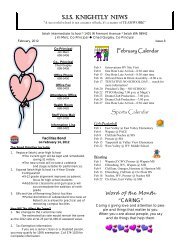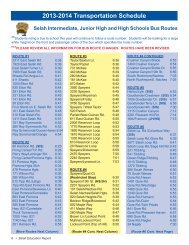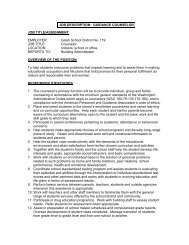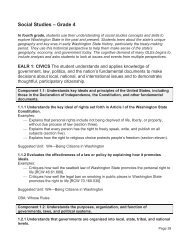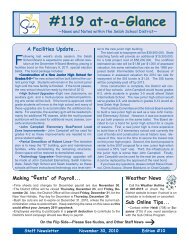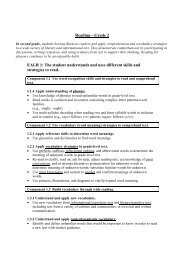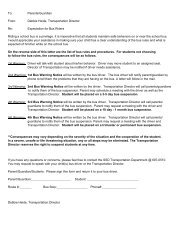Answers Investigation 3
Answers Investigation 3
Answers Investigation 3
You also want an ePaper? Increase the reach of your titles
YUMPU automatically turns print PDFs into web optimized ePapers that Google loves.
<strong>Answers</strong><br />
<strong>Investigation</strong> 3<br />
ACE<br />
Assignment Choices<br />
Problem 3.1<br />
Core 2–4; 28, 30<br />
Other Applications 1; Connections 29, 41<br />
Problem 3.2<br />
Core 5–8<br />
Other Applications 9; Connections 31–33, 38;<br />
unassigned choices from previous problems<br />
Problem 3.3<br />
Core 10, 12– 14, 39, 40, 43<br />
Other Applications 11; unassigned choices from<br />
previous problems<br />
Problem 3.4<br />
Core 15–19, 21<br />
Other Applications 20, 22, 23; Connections 34–37;<br />
Extensions 44, 45; and unassigned choices from<br />
previous problems<br />
Problem 3.5<br />
Core 24, 26<br />
Other Applications 25, 27; Extensions 42, 46;<br />
unassigned choices from previous problems<br />
Adapted For suggestions about adapting<br />
Exercise 1 and other ACE problems, see the<br />
CMP Special Needs Handbook<br />
Connecting to Prior Units 28–32: Accentuate the<br />
Negative; 33: Bits and Pieces II; 37: Covering and<br />
Surrounding<br />
Applications<br />
1. a. You could use a table by trying to find the<br />
cost (C) for every value of n. Thus, the table<br />
would reflect values for n = 1,2,3,...,25.<br />
You could use the graph by finding some<br />
coordinate pairs and then extending the<br />
line formed. You would go over to 25 on<br />
the x-axis (the axis representing the<br />
variable n), and then go up on the y-axis<br />
until you located the line, thus giving you<br />
the value for C.<br />
b. You could use a table by trying to find the<br />
cost (C) for every value of n. Thus, the table<br />
would reflect values for n until you reached<br />
a value of $80 for C. You could use the<br />
graph by finding some coordinate pairs and<br />
extending the line formed. You would go up<br />
to 80 on the y-axis (the axis representing<br />
the variable C), and then go over on the<br />
x-axis until you located the line, thus giving<br />
you the value for n.<br />
c. Sophia was looking for the Cost C of<br />
15 T-shirts.<br />
d. Elisa was looking to see if 30 T-shirts<br />
resulted in a cost of $80.<br />
2. a. Plan 1—the number of km walked<br />
Plan 2—the amount owed in dollars<br />
Plan 3—the number of km walked<br />
b. Plan 1—Solve for x. Divide 14 by 2, which<br />
would give you the kilometers walked;<br />
Plan 2—Solve the right side of the equation<br />
for y. Take 3.5 times 10 (35) and then add<br />
10, thus giving you $45 (the amount owed);<br />
Plan 3—Take 100 minus 55 (45) and then<br />
divide that by 1.5, which would give you the<br />
number of kilometers walked (solving for x).<br />
3. a. y = 45<br />
b. x = 22<br />
c. x = 3<br />
4. a. y = 5x - 15<br />
y = 5(1) - 15<br />
y =-10<br />
ACE ANSWERS 3<br />
<strong>Investigation</strong> 3 Solving Equations 89
. y = 5x - 15<br />
50 = 5x - 15<br />
50 + 15 = 5x - 15 +15<br />
65 = 5x<br />
65<br />
5<br />
=<br />
13 = x<br />
5x<br />
5<br />
c. You could use a table by trying to find the<br />
y for every value of x. Thus, the table would<br />
reflect values for x = 1,2,3,...,13 or<br />
more. By putting the different values of x<br />
into the equation, you would get a value for<br />
y. You could use the graph by finding the<br />
coordinate pairs. You would go over to 1 on<br />
the x-axis, and then go up or down on the<br />
y-axis until you located the line, thus giving<br />
you the value for y. You can do the same<br />
thing to find the x value—either by looking<br />
at all values in a chart that give you either a<br />
particular x or y value or by finding<br />
coordinate pairs by using the graph. For<br />
example, you would go up to 50 on the<br />
y-axis and move along the x-axis until you<br />
came to the correct value (13), which<br />
results in a coordinate pair.<br />
5. 4 coins 6. 5 coins<br />
7. 1 coin 8. 0 coins<br />
9. a. y = 5 + 0.50x. Here x stands for the<br />
number of math questions Rudo gets right,<br />
y stands for the total amount of money his<br />
grandfather gives him, 5 stands for the<br />
birthday money Rudo gets even if he never<br />
answers a single question correctly, and 0.50<br />
stands for the $.50 he gets for every<br />
question he gets right.<br />
b. To buy a shirt that costs $25, we need to<br />
solve the equation:<br />
25 = 5 + 0.50x<br />
20 = 0.50x<br />
x = 40<br />
So he will need to answer 40 questions<br />
correctly to buy the shirt. Note to teacher:<br />
We anticipate that students may use other<br />
methods to solve this problem. It might be<br />
nice to talk about this problem as a class so<br />
that students can reinforce that solving these<br />
kinds of problems algebraically yields the<br />
same answer as solving with a table or graph.<br />
10. a.<br />
c. y = 5 + 0.50(12)<br />
y = 5 + 6<br />
y = 11<br />
So he will make $11. Note to teacher: Here<br />
again students may use tables or graphs to<br />
solve this problem. Make sure they<br />
understand that they can solve this problem<br />
by substituting 12 for x.<br />
Note: You can have students compare this<br />
to the equation for Alana’s pledge plan.<br />
They are the same, but each represents a<br />
different context.<br />
b.<br />
c.<br />
d.<br />
e.<br />
x = 4<br />
x = 7<br />
x = 7<br />
x = 6<br />
<br />
<br />
<br />
x = 2<br />
This can also be shown as three sets of<br />
[a pouch plus 4 coins].<br />
<br />
<br />
90 Moving Straight Ahead
11. a. 21. Take 78 and subtract 15 (15 + 3x = 78),<br />
which is 63. Then divide by 3.<br />
b. 22. Take 83 and add 27 (5x –27= 83),<br />
which is 110. Then divide by 5.<br />
c. <strong>Answers</strong> may vary.<br />
12. a. x =-3 b. x =-10<br />
c. x = 2 3 d. x = 10<br />
4<br />
13. C<br />
25<br />
14. a. x = 5 b. x =<br />
3<br />
25<br />
c. x =- d. x =-5<br />
3<br />
e. x = 5<br />
Note: Students may have various strategies for<br />
solving 3x + 5 = 20. For example<br />
• Using fact families: 7 + 5 = 20, so<br />
15<br />
7 = 20 - 5. If 3x = 15, then x = .<br />
3<br />
• Using an “undoing” metaphor: 3x + 5 = 20,<br />
subtract 5 from both sides, and so on.<br />
• Using properties of equality: 3x + 5 = 20,<br />
3x + 5 - 5 = 20 - 5, and so on.<br />
It would be a good idea to discuss if each of<br />
these strategies will work effectively of ACE 12<br />
also. If not, why<br />
15. a. x = 2 b. x =-12<br />
c. x =-6 d. x =-7<br />
16. Student 1 subtracted 6 from the right-hand<br />
side, instead of distributing the 6 throughout<br />
the parenthesis on the left hand side (used<br />
subtraction to undo multiplication). Student 2<br />
started to distribute the 6 throughout the<br />
parenthesis on the left-hand side, but only<br />
did it to the first variable and forgot to do it<br />
to the second one (it should be 24, as opposed<br />
26<br />
to 4). Correct solution is x =- .<br />
3<br />
17. Student 1: The first step is incorrect. Instead of<br />
subtracting 6, the student should have added<br />
6. The correct answer is 64.5 4 3.5 < 18.43.<br />
Student 2: The student’s answer is wrong due<br />
to incorrect placement of the decimal point.<br />
The answer is approximately 18.4.<br />
18. a. x =-8 b. y = 13<br />
c. y =-2 d. y = 8<br />
e. y = 4<br />
4<br />
217<br />
19. a. x = b. x =<br />
3<br />
3<br />
19<br />
1<br />
c. x = d. x =<br />
3<br />
6<br />
20. You can look at either the x-axis or the y-axis<br />
to find the other coordinate pair by using the<br />
graph made by the line y = 4 - 3x.<br />
21. a. P = 2 b. c =-30<br />
c. You could use a table by trying to find the<br />
P for every value of c. By putting the<br />
different values of c into the equation, you<br />
would get a value for P. You could use the<br />
graph by finding the coordinate pairs. You<br />
would go over to c on the x-axis (the axis<br />
representing the variable c), and then go up<br />
or down on the y-axis (representing the<br />
variable P) until you located the line, thus<br />
giving you the value for P. You can do the<br />
same thing to find the c value—either by<br />
looking up all values in a chart that give<br />
you either a particular c or P value or by<br />
finding coordinate pairs by using the graph.<br />
22. a. i. m = 79.75<br />
ii. m = 15.75<br />
iii. m = 25.99<br />
b. i. d = 12<br />
ii. d =-4.921875<br />
iii. d = 26.328125<br />
23. a. h = 61.4120 + 2.317(46.2) < 168.5 cm<br />
b. h = 81.688 + 2.392(50.1) < 201.5 cm<br />
c. femur < 39.1 cm humerus < 27.7 cm<br />
tibia < 31.4 cm radius < 20.3 cm<br />
d. femur < 50.9 cm humerus < 36.8 cm<br />
tibia < 42.4 cm radius < 28.1 cm<br />
e. The graphs will be straight lines going<br />
upward from left to right. The x-intercept<br />
tells the value for x (femur, tibia, humerus,<br />
or radius length) when the height of the<br />
person is 0, and the y-intercept tells the<br />
value for y (the person’s height) when the<br />
length of a bone is 0. These values do not<br />
make sense in the context of the problem.<br />
24. a. Between 71 and 72 T-shirts;<br />
535 + 4.5n = 12n, n < 71.3<br />
b. A loss, because the expenses, which are<br />
535 + 4.5(50) = $760 exceed the income,<br />
which is 12(50) = $600.<br />
c. There is a profit because when the income<br />
is $1,200, the number of T-shirts is 100.<br />
ACE ANSWERS 3<br />
<strong>Investigation</strong> 3 Solving Equations 91
When the number of T-shirts is 100, the<br />
expenses are $985. Whenever the expenses<br />
are less than the income, there is a profit.<br />
The break-even point is about 72 shirts<br />
sold. Anything over this results in a profit.<br />
d. <strong>Answers</strong> will vary. Possible answers:<br />
For the expenses graph, (10, 580) is on the<br />
graph. This means that the cost of making<br />
10 T-shirts is $580. We know this point will be<br />
on the graph because 580 = 535 + 4.50(10).<br />
(12, 144) is a point on the income graph. This<br />
means that if they sell 12 T-shirts, they will<br />
bring in $144. We know this point will be on<br />
the graph because 144 = 12 3 12. You can<br />
also ask students to find when income is less<br />
than the costs or vice versa. They can use the<br />
graph to answer this question.<br />
25. Students may look at a graph or table of the<br />
relationships C = 50 + 0.10m and C = 0.18m<br />
to determine that International Links would<br />
be cheaper unless the customer talks more<br />
than 625 min per month. Again, you can ask<br />
students when one plan is less than or greater<br />
than the other plan.<br />
26. a. 75 roses (0.5n + 60 = 1.3n, n represents<br />
the number of rose)<br />
b. They do not make a profit, but have a loss<br />
of $20, when they sell 50 roses. They make<br />
a profit of $20 when they sell 100 roses.<br />
They make a profit of $100 when they<br />
sell 200 roses.<br />
27. a.<br />
Cost<br />
$300<br />
$250<br />
$200<br />
$150<br />
$100<br />
$50<br />
Cable Television Cost Plans<br />
y<br />
$0<br />
0 2<br />
4<br />
Company A<br />
6<br />
8<br />
Number of Months<br />
x<br />
10 12<br />
Company B<br />
b. (6, 192) is the point of intersection. This<br />
tells us that the two cost plans are the same<br />
if Ruth uses them for six months.<br />
Connections<br />
28. a. Multiplication; -8(4) =-32<br />
b. Multiplication; -2 4 =-8<br />
c. Multiplication then subtraction;<br />
6(-5) - 10 =-40<br />
d. Multiplication (twice) and then addition;<br />
2(-2) + 3(5) = 11<br />
29. a. no b. no c. yes d. yes<br />
e. no f. yes g. no h. no<br />
30. a. n = 30 +-3 or n = 30 - 3,<br />
-3 = n - 30 or 3 = 30 - n. <strong>Answers</strong> will<br />
vary. Some students may think n = 30 - 3<br />
is easier, some students may not.<br />
b. 5 =-36 - n, n =-36 - 5. <strong>Answers</strong> will<br />
vary.<br />
31. a. A = x(5 + 4); A = 5x + 4x<br />
b. A = 1.5(7 + x); A = 10.5 + 1.5x<br />
32. a. -4 b. -4 c. 4 d. 0<br />
e. -1 f. -1 g. 1<br />
3<br />
14<br />
33. a. x = b. x =<br />
14<br />
3<br />
1<br />
10<br />
c. x =<br />
7<br />
d. x =<br />
9<br />
34. a. 180 degrees b. 360 degrees<br />
c. 720 degrees d. 1,440 degrees<br />
e. 3,240 degrees<br />
35. a. 60 degrees b. 90 degrees<br />
c. 120 degrees d. 144 degrees<br />
e. 162 degrees<br />
36. a. 5 sides b. 8 sides<br />
37. a. x = 2, so the side lengths are 2 cm and<br />
10 cm.<br />
b. x < 3.8 cm.<br />
c. x = 4, so the three side lengths are 8 cm,<br />
6 cm and 10 cm.<br />
d. Area of the rectangle in (a) is 10x, area of<br />
the circle in (b) is px 2 , and area of the right<br />
triangle in (c) is 6x. The area of the<br />
rectangle is 20 cm 2 ; the area of the circle is<br />
about 45.8 cm 2 ; the area of the triangle is<br />
24 cm 2 .<br />
92 Moving Straight Ahead
38. a. C = 50 + 0.10t<br />
b. 10.5 = 630 min, so<br />
C = 50 + 0.10(630) = $113<br />
c. 75 = 50 + 0.10t, so t = 250 min<br />
39. a. n = 4(60) - 160 = 80 chirps/min<br />
150<br />
b. t = + 40 = 77.5 degrees Fahrenheit<br />
4<br />
c. This would be when the number of chirps<br />
0<br />
is 0: t = + 40 = 408 F.<br />
4<br />
d. The y-intercept gives the temperature when<br />
the number of chirps is 0. The coefficient of<br />
n means the ratio of the change of<br />
temperature to the change of number of<br />
chirps. (Note: An interesting question to<br />
raise: If the graph were extended to the<br />
left, what meaning would that part have)<br />
Temperature (F)<br />
1,500<br />
40. a. T = 0 - = 0 - 10 =-108 Celsius<br />
150<br />
300<br />
b. 26 = t - = t - 2; thus t = 288<br />
150<br />
Celsius<br />
41. a. Let H be the height at age 30. Then<br />
h = H - 0.06t.<br />
b. Substitute 160 for h and 35 for t into the<br />
equation. H < 162 cm.<br />
c. 6 ft 6 in = 198.12 cm<br />
h = 198.12 - 50 3 0.06 =195.12<br />
Therefore, he will be 195.12 cm at age 80.<br />
This is about 6 ft 4.8 in.<br />
Extensions<br />
Cricket Chirps<br />
120 y<br />
80<br />
40<br />
x<br />
$0<br />
0 80 160 240<br />
Number of Chirps<br />
42. a. C = 0.55 + 0.23(m - 1); $0.55 is the cost<br />
for the first minute so (m - 1) represents<br />
the cost after the first at a rate of $0.23<br />
per minute.<br />
b. C = 0.55 + 0.23(10 - 1) = $2.62<br />
c. m = about 18.4 min ( Note: This equation<br />
is a little more difficult to solve. Students<br />
may reason through it using words, or they<br />
may solve it symbolically or by using a<br />
graphing calculator.)<br />
4.55 = 0.55 + 0.23(m - 1)<br />
4.55 - 0.55 = 0.55 - 0.55 + 0.23(m - 1)<br />
4 = 0.23(m - 1)<br />
4 0.23(m 2 1)<br />
=<br />
0.23 0.23<br />
17.39 = m - 1<br />
17.39 + 1 = m - 1 + 1<br />
18.39 = m<br />
43. a. 1500 = 150A + 40C<br />
b. 1,500 = 150A + 40(10)<br />
1,500 - 400 = 150A + 400 - 400<br />
1,100 = 150A<br />
1,100 150A<br />
=<br />
150 150<br />
7.33 = A (no more than 7 adults)<br />
c. 1,500 = 150(6) + 40C<br />
1,500 - 900 = 900 - 900 + 40C<br />
600 = 40C<br />
600 40C<br />
=<br />
40 40<br />
15 = C (15 children)<br />
44. a. x =-2.5 b. x = 4.5<br />
c. x =-5.5 d. x =-2.5<br />
45. a. x = 3 (x equals an exact number, which is 3<br />
to make both sides of the expression equal)<br />
b. x = any number (x can equal any number,<br />
to result in the expression of both sides<br />
being equal)<br />
c. No solution (x cannot equal any number to<br />
get the expression to be solved, both sides<br />
of the expression will never be equal).<br />
ACE ANSWERS 3<br />
<strong>Investigation</strong> 3 Solving Equations 93
46. a. (Figure 3)<br />
b. NY to SF: d = 270t; SF to NY: d = 330t<br />
c.<br />
Distance (mi)<br />
5,000<br />
4,000<br />
3,000<br />
2,000<br />
1,000<br />
y<br />
0<br />
0 2<br />
Plane Flying Time<br />
4<br />
SF to NYC<br />
Time (h)<br />
x<br />
10 12<br />
NYC to SF<br />
(Note: Notice that the graph has time on the<br />
horizontal axis and distance on the vertical<br />
axis. Students are accustomed to thinking of<br />
distance as depending on time. The equations<br />
in Question C show this as well. However,<br />
this table is set up in reverse, in a way, as<br />
students are asked to find the time given the<br />
distance. Some students may think of time as<br />
dependent on distance and put time on the<br />
vertical axis. The related equations are<br />
6<br />
8<br />
d<br />
d<br />
= t and = t, and the graph will show<br />
270<br />
330<br />
the distance as x and the time as y.)<br />
d. Against the wind: 5,000 4 270 = 18.52 h;<br />
with the wind: 5,000 4 330 = 15.15 h<br />
Possible <strong>Answers</strong> to<br />
Mathematical Reflections<br />
1. If you were going to solve an equation like<br />
3x + 4 = 10, you would try to make the<br />
equation simpler by using the properties of<br />
equality. In this case, you would subtract 4<br />
from both sides. Then you would have 3x = 6,<br />
so now you would divide both sides by 3 and<br />
the answer would be x = 2.<br />
2. If you were trying to solve the equation<br />
3x + 4 = 10 using the symbolic method, you<br />
would subtract four from both sides and then<br />
divide both sides by 3 to get x = 2. If you<br />
were going to use a table you would find the<br />
pair of values where y = 10 and then find the<br />
corresponding x value. If you were using a<br />
graph to solve the equation, you would go<br />
to 10 on the y-axis and move to the right<br />
horizontally until you intersect the line<br />
3x + 4 = y and then go straight down to the<br />
x-axis and read off that value for x; this finds<br />
the point (x, 10) on the line.<br />
Figure 3<br />
Airplane Flight Times<br />
Distance (mi)<br />
0<br />
200<br />
400<br />
600<br />
800<br />
1,000<br />
1,200<br />
1,400<br />
1,600<br />
1,800<br />
2,000<br />
2,200<br />
2,400<br />
2,600<br />
2,800<br />
3,000<br />
NYC to SF Time (h)<br />
0.00<br />
0.74<br />
1.48<br />
2.22<br />
2.96<br />
3.70<br />
4.44<br />
5.19<br />
5.93<br />
6.67<br />
7.41<br />
8.15<br />
8.89<br />
9.63<br />
10.37<br />
11.11<br />
SF to NYC Time (h)<br />
0.00<br />
0.61<br />
1.21<br />
1.82<br />
2.42<br />
3.03<br />
3.64<br />
4.24<br />
4.85<br />
5.45<br />
6.06<br />
6.67<br />
7.27<br />
7.88<br />
8.48<br />
9.09<br />
94 Moving Straight Ahead







